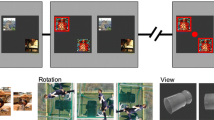Abstract
There are 19 species in genusMacaca and some of them are living in sympatry (Fooden, 1980). Although inter-specific hybrids are relatively easy to produce under artificial conditions, hybridization does not occur naturally. What is preventing that among the species of genusMacaca?
Three rhesus monkeys acquired a discrimination between pictures with rhesus monkeys and without rhesus monkeys. All subjects showed positive transfer of this discrimination to new pictures with rhesus monkeys and without rhesus monkeys. A further test showed that these monkeys could discriminate between pictures of rhesus monkeys and pictures of Japanese monkeys. The results suggest that rhesus monkeys recognize rhesus monkeys as a class, independent of the actual stimuli such as a picture or an individual monkey.
The ability to recognize members of their own species and the opportunities for such learning may be an important factor preventing hybridization among the species of genusMacaca.
Similar content being viewed by others
References
Bernstein, I. S. &T. P. Gordon, 1980. Mixed taxa introductions, hybrids and macaque systematics. In:The Macaques: Studies in Ecology, Behavior and Evolution,D. G. Lindburg (ed.), Van Nostrand Reinhold Co., New York, pp. 125–147.
Chiarelli, B., 1973. Check-list of catarrhina primate hybrids.J. Human Evol., 2: 301–305.
Fooden, J., 1980. Classification and distribution of living macaques (Macaca Lacepede, 1799). In:The Macaques: Studies in Ecology, Behavior and Evolution,D. G. Lindburg (ed.), Van Nostrand Reinhold Co., New York, pp. 1–9.
Fredrickson, W. T. &G. P. Sackett, 1984. Kin preferences in primates (Macaca nemestrina): Relatedness or familiarity?J. Comp. Psychol., 98: 29–34.
Herrnstein, R. J., 1979. Acquisition, generalization and discrimination reversal of a natural concept.J. of Exp. Psychol., Anim. Behav. Processes, 5: 116–129.
————,D. H. Loveland &C. Cable, 1976. Natural concepts in pigeons.J. of Exp. Psychol., Anim. Behav. Processes, 2: 285–302.
———— &P. A. de Villiers, 1980. Fish as a natural categories for people and pigeons. In:The Psychology of Learning and Motivation, Vol. 14,G. H. Bower (ed.), Academic Press, New York, pp. 59–95.
Kawamoto, Y., T. Shotake &K. Nozawa, 1982. Genetic differentiation among three genera of family Cercopithecidae.Primates, 23: 272–286.
Nozawa, K., T. Shotake, Y. Ohkura &Y. Tanabe, 1977. Genetic variations within and between species of Asian macaques.Jap. J. of Genetics, 52: 15–30.
Schrier, A. M., R. Angarella &M. L. Povar, 1984. Studies of concept formation by stumptailed monkeys: Concept humans, monkeys and letter A.J. of Exp. Psychol., Anim. Behav. Processes, 10: 564–584.
Swartz, K. B., 1983. Species discrimination in infant pigtail macaques with pictorial stimuli.Develop. Psychobiol., 16: 219–231.
Author information
Authors and Affiliations
About this article
Cite this article
Yoshikubo, S. Species discrimination and concept formation by rhesus monkeys (Macaca mulatta). Primates 26, 285–299 (1985). https://doi.org/10.1007/BF02382403
Received:
Accepted:
Issue Date:
DOI: https://doi.org/10.1007/BF02382403




